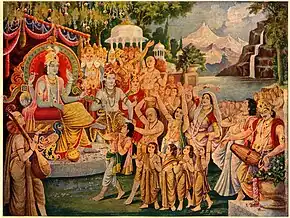
The namasamkirtana (Sanskrit: नामसङ्कीर्तन, romanized: Nāmasaṅkīrtana),[1] also rendered namajapa (Sanskrit: नामजप, romanized: Nāmajapa) is the Hindu practice of congregational chanting of the names and other sacred expressions associated with a given deity. More commonly practised by members of the Vaishnava tradition, the namasamkirtana is characterised by devotees chanting the names of God in a religious gathering, in an expression of bhakti (devotion) and in a bid to achieve devotional ecstasy. This practice is regarded to have become popularised by the traditions that centred around Chaitanya, Vallabha, and Vithoba.[2] The practice is regarded to be a common form of bhajana.[3]
Description
In Vaishnavism, the chanting of any or all of the names of Vishnu, either with or without the help of a japamala (rosary), is regarded to offer punya (religious merit) to the chanter, and is hence an important part of ritualistic worship.[4] Chanting the names of Vishnu is regarded to be a method of salvation in the Kali Yuga.[5]
According to Gaudiya Vaishnavism, the loud chanting and singing of the name of God is regarded to be conducive to attaining salvation, since it is considered to represent a more expressive love of God and thereby constitutes a greater spiritual experience.[6][7]
The recitation of the names of Vishnu is a central theme of many texts, such as the Tiruppavai of Andal.[8]
See also
References
- ↑ Nijenhuis, Emmie te (2018-11-12). Kīrtana: Traditional South Indian Devotional Songs: Compositions of Tyāgarāja, Muttusvāmi Dīkṣitar and Śyāma Śāstri. BRILL. p. 1. ISBN 978-90-04-39188-8.
- ↑ Pillai, S. Devadas (1997). Indian Sociology Through Ghurye, a Dictionary. Popular Prakashan. p. 177. ISBN 978-81-7154-807-1.
- ↑ Sharma, Manorma (2007). Music Aesthetics. APH Publishing. p. 180. ISBN 978-81-313-0032-9.
- ↑ Monier-Williams, Sir Monier (2004). Brahmanism and Hinduism: Or Religious Thought and Life in Asia. Cosmo. p. 105. ISBN 978-81-7755-873-9.
- ↑ Grimes, John A. (1996-01-01). A Concise Dictionary of Indian Philosophy: Sanskrit Terms Defined in English. SUNY Press. p. 157. ISBN 978-0-7914-3067-5.
- ↑ Beck, Guy L. (1995). Sonic Theology: Hinduism and Sacred Sound. Motilal Banarsidass Publ. p. 201. ISBN 978-81-208-1261-1.
- ↑ Rosen, Steven (1994-11-30). Vaisnavism. Motilal Banarsidass Publ. p. 275. ISBN 978-81-208-1235-2.
- ↑ The Secret Garland: Antal's Tiruppavai and Nacciyar Tirumoli. Oxford University Press. 2010-09-30. p. 83. ISBN 978-0-19-983094-7.